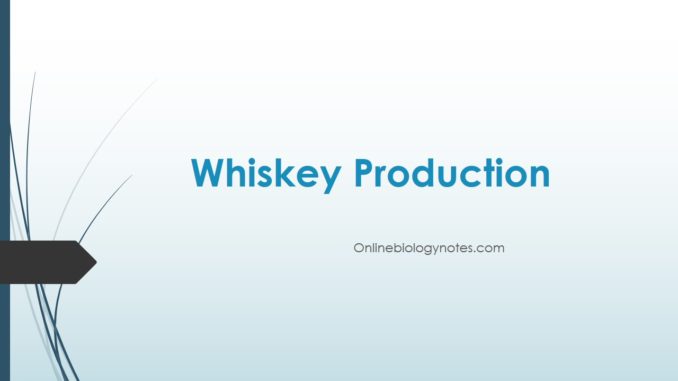
Whisky:
- It is a distilled alcoholic beverage obtained from fermentation of grains followed by distillation and ageing in white oak barrel for 3-4 years.
- Primarily, barley is used but other grains such as corn, wheat, oat & rye are also used.
- Whisky may be malt or non-malt.
- The concentration of ethanol in whisky is not less than 40%.
- Whisky is usually colored with the addition of caramel (burned Sugar).
- Whisky production was first begun on Scotland.
- But some believe that it started on Arabs & Greek.
- Whisky production was supposed to be started first by Irish 1000 years ago.
- But written records suggest that, it was after 1494.
- Microbiology – Improved strains of Saccharomyces Cerevisiae.
- Biosynthesis:
- Glucose —–> Pyruvate —–> Acetaldehyde —-> Ethanol
Steps in whiskey making:
- Various steps involved in whisky production are:
- Selection & Preparation of substrate
- Malting
- Mashing
- Fermentation
- Distillation
- Ageing
- Blending
Step I: Selection and Preparation of substrate:
- Basic substrates used for whisky production are water & grains.
- The water should be free from hazardous material, pesticides, toxic chemicals & heavy metals.
- But it should have high DO value.
- The water containing lime is considered good for whisky production.
- The basic ingredients for whisky include barley, oat, ray, malt etc. but it must be free from fungal infection.
- Beside those substrate other things needed for whisky production are caramel mix (burnt sugar + others).
- According to substrates used, whisky are of:
- Straight whisky: No added ingredients i.e. non-blended
- Blended whisky: Added with different ingredients and sherry (wine)
- Barley—-> malted cooked at 100oC for 3hrs/150oC for 1 hr
- Other grains —-> grounded without malting —-> cooked ta 100oC for 3hrs/150oC for 1 hr
- Cooking liquify starch and break cellulose wall of grains.
Step II: Malting
- Malting is essential for enzyme activity.
- In Scottish whisky, barley germination heating is provided with hot air which is produced from peat burning.
- Peat is soft carbon rich substance when plant matter decomposed in water.
- It provides characteristics smoky flavor to Scottish whisky.
- But, in other countries, hot air is produced by coal burning.
Step III: Mashing
- The malted barley is grounded and mixed with cereals and finally subjected to controlled heating with overall temperature 40-85oC for several days.
- During heating alpha-amylase is converted into beta amylase.
- After mashing it is filtered to obtain wort.
- It is optimized for total sugar content (TSS)= 20-30%.
Step IV: Fermentation
- Mash/wort (TSS=20-30%) —> pH adjusted (3.5-4.5) —-> close fermenter (mostly used)
- Mash/wort (TSS=20-30%) —–> pH adjusted (3.5-4.5) —–> open tank fermenter (require more time, more chance of contamination, more chance of loss of ethanol.
Step V: Distillation
- Now the ethanol is evaporated at 78-80o C.
- In Scotland, distillation is carried out in copper plant or stain less steel.
- Distillation is carried out to obtain 95% ethanol.
- The ethanol should be free from congeners.
- Congeners are the extra things that produces bad flavors such as aldehyde, ketones & other volatile substances.
- It is overcome by production of high % or concentrated ethanol.
- Hard/High wine is produced.
Step VI: Maturation/ Ageing
- The high Wine is diluted with addition of water to obtain the solution with alcohol content 50-65%.
- In the Scotland, the diluted ethanol is kept inside white oak barrel and mouth of the barrel is sealed and kept in cool & wet condition.
- Whereas in American whisky, the ageing is done in warm and dry condition.
- During ageing, the congeners, esters, sugars, and alcohols react together to form special type of aroma.
- Ageing is conducted minimum for 3-4 years & maximum up to 10-15 years.
Step VII: Blending
- In blending, appropriate proportion of different whisky of previous batch is mixed with the aged whisky.
- At the same time, the appropriate proportion of Sherry port & other things are also mixed to develop flavors.
- Finally, caramel mix is added in appropriate amount to develop a suitable color.
- Finally, it is checked by testing with master blender.
